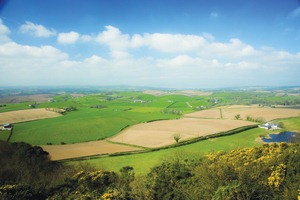Review of climate policy
Environment Minister Phil Hogan is preparing for the post-Kyoto world. Stephen Dineen reports.
The Minister for the Environment’s review of climate change is almost complete and a revised policy is expected to outline challenges facing Ireland in the period before and after 2020.
A spokesman for the Department told eolas: “The clear priority is to develop policy that responds to the specific challenges that exist for Ireland and consideration is currently underway of how best to engage all stakeholders in that next phase of policy development.”
The Programme for Government commits to publishing a climate change bill “in line with negotiated EU 2020 targets.”
Ireland’s current climate change policy is contained in the 2007-2012 National Climate Change Strategy. Based on the Kyoto commitment of Ireland limiting greenhouse gas emissions to 13 per cent above 1990 levels, it contains a list of actions including 33 per cent of electricity to come from renewables by 2020 (this was subsequently revised to 40 per cent), a sustainable travel action plan, revised building regulations, new supports for afforestation and a public sector efficiency programme to reduce energy consumption by 33 per cent.
Under the 2009 EU Effort Sharing Decision, Ireland is required to reduce greenhouse gas emissions by 20 per cent in the non-Emissions Trading Scheme (ETS) sector (agriculture, transport, waste and non-trading industrial, commercial and residential activities). Ireland is also part of the ETS, which aims for a 21 per cent reduction on 2005 levels by 2020.
In December 2010, the previous government published a Climate Change Response Bill, which fell with the last administration. Based on the goals of a low carbon economy and integrating climate change policy into other government policies, it had three non-justiciable (not for judicial resolution) targets: an annual 2.5 per cent reduction in emissions on 2008 levels (a compounded 26 per cent reduction by 2020), and targets of 40 per cent by 2030 and 80 per cent by 2050 on 1990 levels (including mitigation from carbon sinks in forestry).
It also provided for a national climate change expert advisory body, an annual transition statement from government on progress, greenhouse gas emissions implications to form part of the financial budget, and ministers being held responsible for mitigation and adaptation in economic sectors under their responsibility.
In its 2010 annual report, the EPA stated that “the profile of greenhouse gas emissions in Ireland is unusual in the European context, with agriculture currently accounting for 28 per cent of all emissions and 39 per cent of emissions in the non-trading sector.” This would make it “very difficult to effect actual reductions on the scale required in the non-trading sector.”
It published research in 2011 showing that the three largest contributing sectors to emissions during the 2008-2012 period will be agriculture (29 per cent), energy (22 per cent) and transport (21 per cent).
Erik O’Donovan, IBEC’s senior energy policy executive, told eolas that there will have to be “equity of effort” by sectors in reducing emissions. He stated: “We have a national renewable energy action plan, we have a national energy efficiency action plan, and we probably need a national climate change action plan now,” with a need for “particular co-ordination of energy and climate policy ambitions and actors.”
An Irish Farmers’ Association spokesman stated that any climate change legislation must take account of sustainable agricultural practices in Ireland compared with those in former forested lands such as the Amazonian region.
Friends of the Earth Director Oisín Coughlan said that the current review “should not delay progress” towards the delivery of climate change law or “the stated timeline by Phil Hogan and Eamon Gilmore, that the bill will be passed next year.” Coughlan said the Bill produced by the Oireachtas Climate Change and Energy Security Committee in the last Dáil (different to the previous government’s Bill) was “a good model” and should be sent to the new Oireachtas Environment Committee for consideration.
Among the differences between the two Bills was that the Committee’s Bill provided for five-year legally binding targets (through carbon budgets) and accountability to lie with the Taoiseach. It also allowed for a domestic carbon offset scheme, which the government-sponsored Bill did not.






